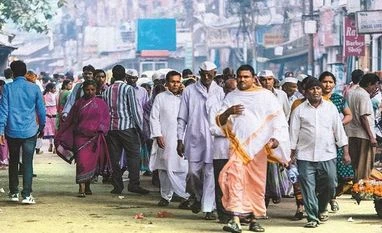At the end of its term, the current Narendra Modi-led National Democratic Alliance (NDA) government amended the Constitution to make room for 10 per cent reservation in government jobs and higher education for the “poor” in the general category.
While there was little political opposition to this move, constitutional experts did criticise it on principle, saying that the genesis of reservations in India was based on historical injustice, and not relative backwardness or under-development of communities or groups.
But how are government jobs, including those of teachers, being filled up as of today?
To get a rough answer to this question, we look at the dynamics of the positions occupied in the government, the 23 Institutes of Technology (IITs) and the 40 Central Universities (CUs) spread across India.
General-category persons take up more than 50 per cent of government jobs. Further, their share rises as we go higher up the rank and file, at about 70 per cent in Group A, or Class-1 posts. In IITs, most of the vacant faculty positions probably pertain to reserved-category candidates, since SCs and STs together account only for three per cent of all filled posts at the moment.
In Central Universities, faculty positions reserved for SCs and STs lying vacant are as high as 40-50 Per cent, and ahead of those meant for general category candidates, at 28 per cent. In addition, the situation of SCs and STs in the position of Professor and Associate Professor—the two top posts in any university—is worse, where less than half or a third of the positions from these categories are filled. In Assistant Professor positions, their situation is similar to that of general category posts.
First, let us look at government jobs. The Group “A” or the top level-positions, such as secretaries, and joint secretaries, are still heavily dominated by the general category, at 70 per cent (see chart 1). If the economically weak from the general category get reservation, a situation where this share rises further cannot be ruled out.
Now, looking at the overall jobs including Group “B” and “C” or the subordinate positions in the government, the share of general category reduces. This shows that as we go down the rank and file, reserved category candidates occupy larger shares. The share of general category officers lies near 60 per cent.
Interestingly, the share of OBC officers in the government sector has risen from 19 per cent to 25 per cent in five years to 2015; in the process, it has grabbed a large slice of general category posts, whose share of officers has reduced (see chart 2).
Now, while the share of general candidates in Group “A” positions has remained nearly constant, that of OBCs has most probably risen in lower-level positions. Part of this could be explained by the fact that the share of OBCs in persons inducted by direct recruitment through selection is above 33 per cent, more than the 27 per cent reservation for the category (See chart 3).
AS the OBC-General dynamics changed over time, the share of SCs and STs in the government has remained constant, suggesting that relatively upwardly mobile OBCs have benefitted the most. To put the recent amendment in perspective, upper castes or general category candidates are generally better placed than their OBC, SC or ST counterparts, and this could have unexpected ramifications.
Looking from the position of the under-privileged classes, the situation in the Indian Institutes of Technology (IITs) is worse. The fact that more than 30 per cent faculty positions in the IITS are vacant is well-known. But most of the vacancies are positions reserved for SCs and STs, which is evident from the fact that the filled positions are heavily inclined towards general category professors and teachers.
Of the 6,043 filled posts, a minuscule 149, or 2.4 per cent, are occupied by SCs, and a mere 21 by STs, taking their share together to less than 3 per cent.
As union minister for human resources development Prakash Javadekar says, if all educational institutes create 25 per cent more seats to implement upper caste reservation, the vacuum in SC/ST reserved faculty posts in IITs would still remain.
Finally, let us look at the teacher positions in Central Universities. In CUs, about 32 per cent faculty posts are lying vacant as of April 2018. But the incidence of vacancy is more in the case of reserved posts. As against a vacancy of 28 per cent in general category faculty positions, that in SC and ST positions is 42 per cent and 48 per cent, respectively (see chart 4).
But this is the tip of the iceberg. For SCs, the vacancy in the position of Professor is 83 per cent, and for the position of Associate Professor is 75 per cent. For STs, it is 92 per cent and 86 per cent, respectively, against 48 per cent and 38 per cent in the general category.
Though the absolute number of positions in the top level teacher jobs are lesser than that in the lower levels, the chance of vacancy is more for SCs and STs at the top positions.
If the existing provisions of reservation are shaky on ground, whether the additional reservation for upper castes restores or deteriorates the balance is the question that needs attention.
Unlock 30+ premium stories daily hand-picked by our editors, across devices on browser and app.
Pick your favourite companies, get a daily email with all news updates on them.
Full access to our intuitive epaper - clip, save, share articles from any device; newspaper archives from 2006.
Preferential invites to Business Standard events.
Curated newsletters on markets, personal finance, policy & politics, start-ups, technology, and more.



)